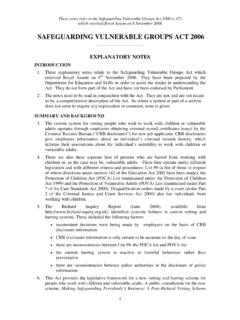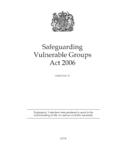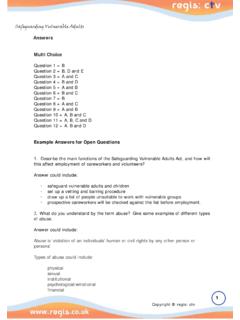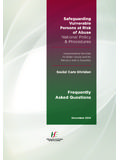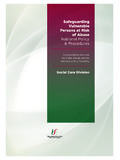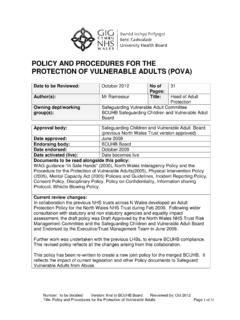Transcription of Pressure Ulcers and the interface with a Safeguarding Enquiry
1 January 2018 Safeguarding Adults Protocol Pressure Ulcers and the interface with a Safeguarding Enquiry 2 DHSC ID box Title: Pressure Ulcer Protocol Author: Chief Social Worker for the Department of Health and Social Care 18277 Document Purpose: Guidance Publication date: January 2018 Target audience: Health and social care practitioners and managers Contact details: Department of Health and Social Care, 39 Victoria Street, London SW1H 0EU You may re-use the text of this document (not including logos) free of charge in any format or medium, under the terms of the Open Government Licence. To view this licence, visit Crown copyright 2016 Published to , in PDF format only. 3 Contents Contents .. 3 Foreword .. 4 1. Introduction .. 6 2. Aim .. 8 3. Scope .. 9 4. Impact .. 11 5. Background .. 12 6. Definitions .. 13 7. Safeguarding Concern Assessment Guidance.
2 14 8. Appendices .. 17 Appendix 1: Guidance for completing the adult Safeguarding decision guide .. 17 Appendix 2: Decision Process .. 19 Appendix 3: Adult Safeguarding Decision Guide for individuals with severe Pressure Ulcers .. 20 Appendix 4: Body Map .. 23 Appendix 5: Adult Safeguarding concern proforma regarding Pressure ulceration .. 24 References .. 27 Acknowledgements .. 28 4 Foreword I am delighted to publish this guidance with the aim of assisting practitioners and managers across health and care organisations to provide caring, speedy and appropriate responses to individuals at risk of developing Pressure Ulcers . Prevention of Pressure Ulcers is not only ideal but, in most cases, perfectly possible. Taking a proactive approach will reduce harm to individuals and secure efficiencies to the wider health and social care system. Where Pressure Ulcers do occur this guidance offers a clear process for the clinical management of the removal and reduction of harm to the individual, whilst considering if an adult Safeguarding response under section 42 of the Care Act 2014 is necessary.
3 The guidance demonstrates that the focus on removing harm to the individual will usually be secured by speedy clinical intervention. Broader issues of overall quality of care, management of a service, and training of staff will be of significant interest to commissioners, and the regulator the Care Quality Commission, as well as Safeguarding Adult Boards and Quality Surveillance Groups. There should be clear processes in every locality for communicating concerns to the relevant bodies. Pressure Ulcers , largely preventable, cause distress to individuals and their families, as well as creating additional financial pressures for the NHS. Whilst the treatment and response to Pressure Ulcers is a predominantly a clinical one, the prevention of them our ultimate goal is a shared responsibility. The reality is that many people at risk of Pressure Ulcers are receiving services that are commissioned, arranged and provided by non-clinical staff in the social care sector.
4 It is vital that any assessment, including risk assessments, address the likelihood of Pressure Ulcers developing and what action must be taken to prevent them. This will be as true for an individual living at home as those living in a regulated care setting. It is also vital that carers, whether family/friends or paid carers, receive training in the prevention and signs of developing Pressure Ulcers . Those responsible for carrying out assessments and arranging services need to be alert to this issue and have easy access to clinical advice to support care planning. The content of this guidance reflects the six principles of adult Safeguarding originally developed in 2011 and re-stated in the Care Act statutory guidance. I would urge everyone to familiarize themselves with those principles and ensure that their organisational procedures and practice are consistent with them.
5 This is a real opportunity to improve the lives of individuals and their families in a way that has the potential to significantly improve the quality of life for a great many people and I urge you to collaborate with partners at a local level to bring about positive change. Lyn Romeo Chief Social Worker for Adults 5 6 1. Introduction This protocol will provide a framework for health and care organisations to draw on when developing guidance for staff in all sectors and agencies that may see a Pressure ulcer. If the staff member is concerned that the Pressure ulcer may have arisen as a result of poor practice, neglect/abuse or an act of omission, the local guidance should be clear about what steps they need to take and whether the local authority Safeguarding duties are triggered. From a governance perspective, each organisation that utilises this protocol will be responsible for ensuring that local guidance reflects the protocol is used appropriately and that is use monitored.
6 Safeguarding Adult Boards (SABs) and Quality Surveillance Groups (QSGs) will want to be reassured that this is the case. This protocol should be applied to Pressure Ulcers reported by anyone including care providers, clinicians, anyone undertaking Safeguarding enquiries, unpaid carers, relatives and individuals themselves, as any tissue damage resulting from Pressure should be considered. This protocol has been developed and agreed in the broader context of the implementation of the Care Act 2014 and the drive towards greater integration between the health and social care systems. The core principle underpinning the Care Act is promoting individuals well-being. The imperative for this protocol derived from the increasing concern across the sector about the prevalence of Pressure Ulcers , in all settings, and a lack of consensus about how investigating Pressure Ulcers should interface , or not, with local authority Safeguarding duties as set out in the Care Act 2014 and the accompanying statutory Practice in some places does not promote individuals well-being and threatens to overwhelm the local authority adult Safeguarding system.
7 There has been no previous national standard protocol advising and supporting organisations in regard to Pressure Ulcers or the decision making process as to whether a Safeguarding concern should be raised with the local authority in order for them to decide if a section 42 Safeguarding Enquiry is required. Those at risk of Pressure Ulcers are cared for in many different settings across health and social care, including their own home. Terminology used in these settings may vary, the term patient, resident, service user, and clients are all often used. For the purpose of this guidance the term individual or person will be used throughout. A helpful beginning point is the principle of well-being. As it states in the Care and Support statutory guidance:2 Wellbeing is a broad concept, and it is described as relating to the following areas in particular: personal dignity (including treatment of the individual with respect) physical and mental health and emotional wellbeing protection from abuse and neglect 1 guidance# Safeguarding -1, Paragraphs , and 2 paragraph 7 control by the individual over day-to-day life (including over care and support provided and the way it is provided) participation in work, education, training or recreation social and economic wellbeing domestic, family and personal suitability of living accommodation the individual s contribution to society This principle requires all agencies to work together to achieve the best outcomes for the individual.
8 The Care Act clearly lays out the duties of relevant partners to cooperate including, but not only, local authorities and NHS bodies. This requires a shift of approach from one dominated by processes and tick boxes to a person-centred model that begins with the person at the centre of the concerns and fully involves them or their representative as appropriate. The response to the presence of Pressure Ulcers should involve the individual and their family, explaining the concerns and seeking their views. Several organisations including the Department of Health, Care Quality Commission, NHS England, Association of Directors of Adult Social Services and Health Education England have worked with the Tissue Viability Society, to review current guidance and practice in relation to Pressure Ulcers and Safeguarding . Following a request to share information, several health trusts, listed at the end of this document, have submitted their local protocols for review.
9 These have contributed to the discussions resulting in this protocol. Safeguarding Adults Protocol 8 2. Aim The aim of this protocol is to provide a national framework, identifying Pressure Ulcers as primarily an issue for clinical investigation rather than a Safeguarding Enquiry led by the local authority. Indicators to help decide when a Pressure ulcer case may additionally need a Safeguarding Enquiry are included. Whilst the operational responsibility for investigating Pressure Ulcers is largely health led, the local Safeguarding Adult Boards (SABs) have a strategic interest in the prevalence of Pressure Ulcers across the sectors as one indicator of quality of care. It is important that both the SABs and Quality Surveillance Groups (QSGs) have access to comprehensive data on a regular basis. Where a Pressure ulcer is one of a number of Safeguarding concerns in relation to an individual or setting then there should be a multi-agency approach coordinated by the local authority, with health taking the lead for the clinical investigation.
10 9 3. Scope The Care Act 2014 states clearly that concerns about the quality of a service provided are not automatically Safeguarding concerns under section 42 of the Safeguarding is about protecting an individual s right to live in safety, free from abuse and neglect. It is about people and organisations working together to prevent and stop both the risk and experience of abuse or neglect, while at the same time making sure that the adult s wellbeing is promoted including, where appropriate, having regard to their views, wishes, feelings and beliefs in deciding on any action. Safeguarding Adults is used to describe all work to help adults with care and support needs stay safe from abuse and neglect. It replaces the term adult protection . The term adult at risk of abuse and neglect has been used to replace vulnerable adult , (DoH, 2000).










